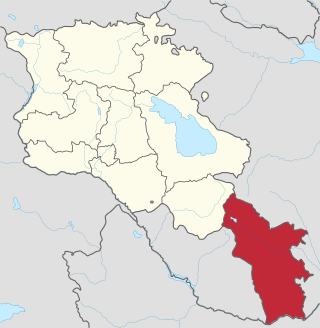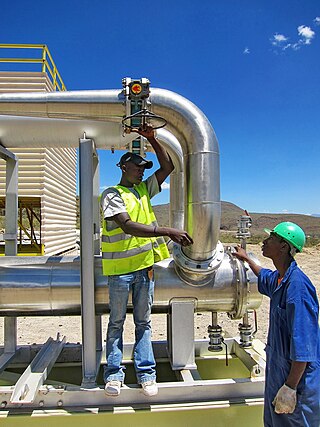It is proposed that this article be deleted because of the following concern:
If you can address this concern by improving, copyediting, sourcing, renaming, or merging the page, please edit this page and do so. You may remove this message if you improve the article or otherwise object to deletion for any reason. Although not required, you are encouraged to explain why you object to the deletion, either in your edit summary or on the talk page. If this template is removed, do not replace it . The article may be deleted if this message remains in place for seven days, i.e., after 20:58, 11 July 2023 (UTC). Find sources: "Jermaghbyur Geothermal Power Plant" – news · newspapers · books · scholar · JSTOR Nominator: Please consider notifying the author/project: {{ subst:proposed deletion notify |Jermaghbyur Geothermal Power Plant|concern=Old proposal has not moved forward to construction, lacks notability.}} ~~~~ |
| Jermaghbyur Geothermal Power Plant | |
|---|---|
| Country | |
| Location | Jermaghbyur, Syunik |
| Status | Proposed |
| Power generation | |
| Nameplate capacity | 150 MW |
The Jermaghbyur Geothermal Power Plant will be Armenia's largest geothermal power plant having an installed electric capacity of 150 MW. It will be situated in Syunik Province of Armenia. [1] [2]

Geothermal energy is the thermal energy in the Earth's crust which originates from the formation of the planet and from radioactive decay of materials. The high temperature and pressure in Earth's interior cause some rock to melt and solid mantle to behave plastically. This results in parts of the mantle convecting upward since it is lighter than the surrounding rock. Temperatures at the core–mantle boundary can reach over 4000 °C (7200 °F).

Syunik is the southernmost province of Armenia. It is bordered by the Vayots Dzor Province to the north, Azerbaijan's Nakhchivan Autonomous Republic exclave to the west, Azerbaijan to the east, and Iran to the south. Its capital and largest city is the town of Kapan. The Statistical Committee of Armenia reported its population was 141,771 in the 2011 census, down from 152,684 at the 2001 census.

Iceland is a world leader in renewable energy. 100% of Iceland's electricity grid is produced from renewable resources. In terms of total energy supply, 85% of the total primary energy supply in Iceland is derived from domestically produced renewable energy sources. Geothermal energy provided about 65% of primary energy in 2016, the share of hydropower was 20%, and the share of fossil fuels was 15%.

Geothermal power in Australia was at one time hoped to provide cost effect, renewable power for Australia. There are locations that have been shown to contain hot granites at depth which hold good potential for development of geothermal energy. Exploratory geothermal wells have been drilled to test for the presence of high temperature geothermal reservoir rocks and such hot granites were detected. However, all these projects have since been abandoned. A small geothermal plant in Queensland experienced problems during commissioning and as at May 2022, remains idle.

Geothermal energy was first used for electric power production in the United States in 1960. The Geysers in Sonoma and Lake counties, California was developed into the largest geothermal steam electrical plant in the world, at 1,517 megawatts. Other geothermal steam fields operate in the western US and Alaska.
Portugal is a producer of geothermal power, and their main investment is in the Azores. While electricity is only produced on São Miguel, Azores, direct-use applications are also at Chaves in northern Portugal, and at S. Pedro do Sul in central Portugal and at the Lisbon Air Force Hospital.

Geothermal power is electrical power generated from geothermal energy. Technologies in use include dry steam power stations, flash steam power stations and binary cycle power stations. Geothermal electricity generation is currently used in 26 countries, while geothermal heating is in use in 70 countries.

Lernadzor is a village in the Kajaran Municipality of the Syunik Province in Armenia.

Spandaryan is a village in the Gorayk Municipality of the Syunik Province in Armenia. The area around the village contains the Spandaryan Hydro Power Plant, one of Armenia's largest hydro power plants and the Spandaryan Reservoir to the northwest of the village itself.

Energy in Armenia is mostly from natural gas. Armenia has no proven reserves of oil or natural gas and currently imports most of its gas from Russia. The Iran-Armenia Natural Gas Pipeline has the capacity to equal imports from Russia.

Geothermal power is very cost-effective in the Great Rift Valley of Kenya, East Africa. As of 2023, Kenya has 891.8 MW of installed geothermal capacity. Kenya was the first African country to build geothermal energy sources. The Kenya Electricity Generating Company, which is 74% state-owned, has built several plants to exploit the Olkaria geothermal resource; Olkaria I, Olkaria II, Olkaria IV, Olkaria V, and Wellhead generation plants, with a third private plant Olkaria III. Additionally, a pilot wellhead plant of 2.5 MW has been commissioned at Eburru and two small scale plants have been built by the Oserian Development Company to power their rose farm facilities with a total of 4 MW.

The Hellisheiði Power Station is the eighth-largest geothermal power station in the world and largest in Iceland. The facility is located in Hengill, southwest Iceland, 11 km (7 mi) from the Nesjavellir Geothermal Power Station. The plant has a capacity of 303 MW of electricity and 400 MWth of hot water for Reykjavik's district heating. The power station is owned and operated by ON Power, a subsidiary of Reykjavík Energy.

Imperial Valley Geothermal Project is a complex of eleven geothermal power stations located in the Salton Sea Geothermal Field, along the southeastern shore of the Salton Sea in the Imperial Valley of California. It is the second largest geothermal field in the United States after The Geysers in Northern California.

Geothermal power accounts for about 1.6-1.8% of the total electric energy production in Italy and is about 7% of the total renewable energy produced in 2010. The total energy from Geothermal was 5,660 GWh in 2015. Italy is the seventh country by geothermal installed capacity.

San Emidio Geothermal Plant, in Washoe County, Nevada, is a geothermal power plant with a design capacity of 11.8 megawatts (15,800 hp). The upgraded plant went online on May 25, 2012.
The Gümüşköy Geothermal Power Plant is an air-cooled Organic Ranking Cycle (ORC) system geothermal power plant located at Gümüşköy village of Germencik district in Aydın Province, Turkey. The power plant feeds from the 182 °C Gümüşköy Geothermal Reservoir, which was discovered with the GK-1 geothermal well in October 2008.

Renewable energy in Armenia ranges from geothermal, hydroelectric, solar and wind energy in Armenia.
The Karkar Geothermal Power Plant (Karkar GTPP) (Armenian: Կարկառի երկրաջերմաէլեկտրակայան) is a proposed geothermal power plant to be constructed in Armenia. The plant will be the first of its kind in Armenia and will be situated at the Karkar site in the southernmost province of Armenia, Syunik. Initial studies envisage the construction of a 28-30 MW capacity geothermal power plant with an annual electric output of 250 million kilowatt hours (kWh) according to data provided in 2016. The Karkar GTPP will allow for the production of heat to be used in the heating of greenhouses, residential buildings, and industrial sites. Commissioned in 2008-2009, the Karkar GTPP is a unique project in Armenia in that it does not possess an analogue in the region, and positively differs from other energy producing power plants in its renewability of resources, independence from imported energy sources, as well as its minimal environmental impact.
The Soda Lake Geothermal Field is located on the northeast flank of the Soda Lakes volcano, west of the city of Fallon, Nevada in Churchill County.